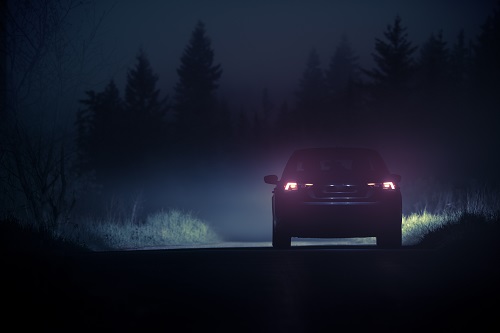Driving at Night Safety Tips
According to the National Highway Traffic Safety Administration, deaths on the road triple when the figures specifically describe nighttime fatalities. This isn’t a surprise, as human beings are notoriously not nocturnal, and you need to be extra careful when driving after the sun has gone down because of it. Despite your headlights illuminating the road, standard low beams typically only stretch between 160 and 250 feet ahead of your vehicle while typical high beams only shine at a maximum rate of 500 feet. You need about 200 feet to come to a complete stop, and if you’re driving around 60 mph, that leaves very little room for error. With this in mind, here are a few tips to help you better traverse the roads after dark and keep yourself safe.
Aiming Headlights
It’s possible even with brand-new vehicles for the headlights to be uneven or even pointed too low, so it’s best to check them and try aiming them properly. You can do it on your own using the owner’s manual for your vehicle, but make sure you don’t blind oncoming traffic with the way they’re pointed. Also, be sure that you’re cleaning road grime off your headlights regularly with a polish kit from your local automotive store.
Spotting Retinas
Night driving means coming across nocturnal critters of differing sizes, such as opossums and raccoons, but you also need to watch for those that would cause greater damage to your vehicle, such as elk, moose, or deer. As stated previously, high beams don’t really shine beyond stopping distance, which means avoiding deer and similar creatures takes a very specific skill—spotting eyes after they reflect the light from your headlights. These tiny bright pinpoints typically appear much further down the road, which should give you extra time to slow down or stop. When you encounter large animals, your best response is slowing down quickly without leaving the right lane or going off the side of the road.
Avoiding Staring Contests with Oncoming Lights
The lights from oncoming vehicles can greatly disrupt a driver’s concentration in the evening. Within your vehicle, your eyes have adjusted to your instrument panel’s dim glow as well as the darkened road ahead of you. It’s easy to get distracted and then stare into bright road signs or an 18-wheeler’s headlights without even knowing it. You need to keep your gaze turned away from other road lights, especially high beams. Even if you’re trying to determine whether an oncoming vehicle’s high beams are misaligned or even on, look the other way. If a vehicle behind yours has its high beams turned on, you can usually adjust your rearview mirror and keep the light out of your vision.
If you have a teen driver in need of behind the wheel training, we can help. Training Wheels is one of the top-ranked driving schools in the Atlantic City area specializing in teaching new teen drivers. For more information about our services, please click here. Or, you can speak directly with Training Wheels owner Keith Cimaglia at (609-241-0118)

